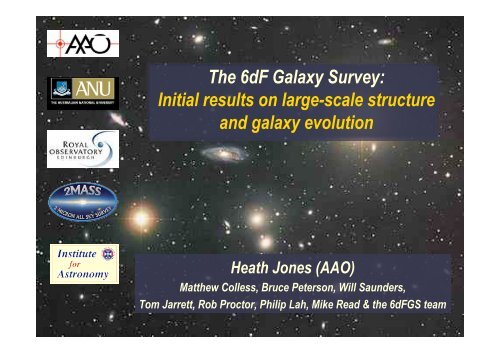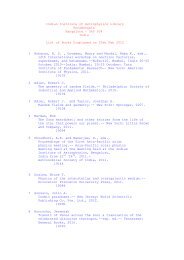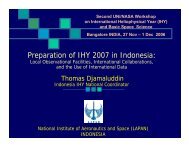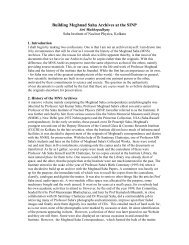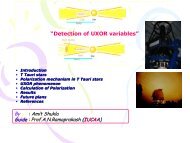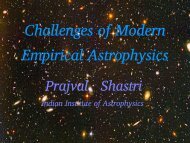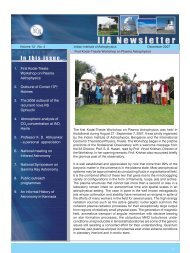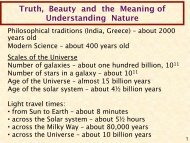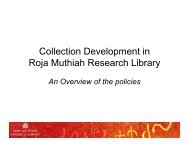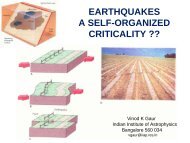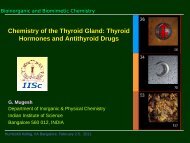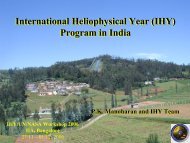The 6dF Galaxy Survey: Initial results on large-scale structure and ...
The 6dF Galaxy Survey: Initial results on large-scale structure and ...
The 6dF Galaxy Survey: Initial results on large-scale structure and ...
- No tags were found...
Create successful ePaper yourself
Turn your PDF publications into a flip-book with our unique Google optimized e-Paper software.
<str<strong>on</strong>g>The</str<strong>on</strong>g> <str<strong>on</strong>g>6dF</str<strong>on</strong>g> <str<strong>on</strong>g>Galaxy</str<strong>on</strong>g> <str<strong>on</strong>g>Survey</str<strong>on</strong>g>:<str<strong>on</strong>g>Initial</str<strong>on</strong>g> <str<strong>on</strong>g>results</str<strong>on</strong>g> <strong>on</strong> <strong>large</strong>-<strong>scale</strong> <strong>structure</strong><strong>and</strong> galaxy evoluti<strong>on</strong>Heath J<strong>on</strong>es (AAO)Matthew Colless, Bruce Peters<strong>on</strong>, Will Saunders,Tom Jarrett, Rob Proctor, Philip Lah, Mike Read & the <str<strong>on</strong>g>6dF</str<strong>on</strong>g>GS team
<str<strong>on</strong>g>The</str<strong>on</strong>g> Anglo-Australian Observatory• <str<strong>on</strong>g>The</str<strong>on</strong>g> Anglo-Australian Observatorywas created in 1974 as part of a binati<strong>on</strong>alagreement between Australia<strong>and</strong> Britain, to operate the 3.9m Anglo-Australian Telescope• It employs around 70 people based attwo sites:–Siding Spring Observatory,located ~450 km northwest ofSydney in the WarrumbungleMountains,– its Headquarters, located in theSydney suburb of Epping• In 1988 it took over management ofthe 1.2m UK Schmidt Telescope (fromthe Royal Observatory in Edinburgh)
<str<strong>on</strong>g>The</str<strong>on</strong>g> Anglo-Australian Telescope (AAT)• 3.9 m diameter Ritchey-Chretien telescope with focal stati<strong>on</strong>s at prime (f/3.3),cassegrain (f/8 <strong>and</strong> f/15) <strong>and</strong> coude (f/36).• Open to internati<strong>on</strong>al subscripti<strong>on</strong> with successful proposals charged timeproporti<strong>on</strong>al to Aus/UK/other participati<strong>on</strong>: over-subscripti<strong>on</strong> rate ~3 to 5 times.Instrument workload:AAOmega (68%), IRIS2 (17%),UCLES (8%), SPIRAL (7%)• Current instrumentati<strong>on</strong>:IRIS2: infrared imager/spectrograph(7.7’ x 7.7’ FOV in JHK)SPIRALIRIS2SPIRAL: 512-element, 22.4” x11.2” FOV integral field unitUCLES / UHRF: high resoluti<strong>on</strong>echelle spectrograph (R ~ 40k to100k <strong>and</strong> ~300k to 940k)AAOmega: 392-fibre, 2 o FOV,multi-object optical spectrograph
AAOmega• <str<strong>on</strong>g>The</str<strong>on</strong>g> centrepiece of AAOmega (<strong>and</strong>its predecessor, 2dF) is a roboticfibre-positi<strong>on</strong>er at prime focus• It can c<strong>on</strong>figure fibres for ~400sources in ~70 mins -- the same timeit takes to complete an observati<strong>on</strong>X• As there are 2 switchable field plates,no time is lost between observati<strong>on</strong>s• <str<strong>on</strong>g>The</str<strong>on</strong>g> transformati<strong>on</strong> of 2dF to AAOmegasaw both spectrographs replacedX
AAOmega• <str<strong>on</strong>g>The</str<strong>on</strong>g> centrepiece of AAOmega (<strong>and</strong>its predecessor, 2dF) is a roboticfibre-positi<strong>on</strong>er at prime focus• It can c<strong>on</strong>figure fibres for ~400sources in ~70 mins -- the same timeit takes to complete an observati<strong>on</strong><str<strong>on</strong>g>The</str<strong>on</strong>g> 2dF <str<strong>on</strong>g>Galaxy</str<strong>on</strong>g>Redshift <str<strong>on</strong>g>Survey</str<strong>on</strong>g>221,414 redshiftsz 1/2= 0.11b J< 19.5• As there are 2 switchable field plates,no time is lost between observati<strong>on</strong>s• <str<strong>on</strong>g>The</str<strong>on</strong>g> transformati<strong>on</strong> of 2dF to AAOmegasaw both spectrographs replaced2dF <str<strong>on</strong>g>Galaxy</str<strong>on</strong>g> Redshift <str<strong>on</strong>g>Survey</str<strong>on</strong>g>(1998 - 2003): 221k redshifts,>130 publicati<strong>on</strong>s, >600 citati<strong>on</strong>s formain survey paper al<strong>on</strong>e
<str<strong>on</strong>g>The</str<strong>on</strong>g> United Kingdom Schmidt Telescope (UKST)• Built around the same time as theAAT, as a wide-field photographicsurvey telescope• Managed by AAO since 1988• Six-Degree Field instrument (2001):multi-object spectroscopy of up to150 objects over a 5.7 o FOV• Current survey: RAVE - the RAdialVelocity Experiment (2004 to ~2011)– Radial velocities, metallicities <strong>and</strong>abundances for up to a milli<strong>on</strong> disk<strong>and</strong> halo stars• Previous survey: <str<strong>on</strong>g>The</str<strong>on</strong>g> <str<strong>on</strong>g>6dF</str<strong>on</strong>g> <str<strong>on</strong>g>Galaxy</str<strong>on</strong>g><str<strong>on</strong>g>Survey</str<strong>on</strong>g> (2001 to 2006)
Ongoing Instrumentati<strong>on</strong> Projects“STARBUGS”(McGrath & Haynes 2006)Integrated Phot<strong>on</strong>icSpectrographsNight-Sky Line Suppressing Fibres(Bl<strong>and</strong>-Hawthorn & Hort<strong>on</strong> 2006)• Aiming to suppress 98% skyemissi<strong>on</strong> over z, J, H b<strong>and</strong>s–Need to solve for single-mode<strong>and</strong> then multi-mode
<str<strong>on</strong>g>The</str<strong>on</strong>g> AAO in 2008 <strong>and</strong> bey<strong>on</strong>d• <str<strong>on</strong>g>The</str<strong>on</strong>g> AAO <strong>and</strong> its facilities are now 33years old• <str<strong>on</strong>g>The</str<strong>on</strong>g> UK will withdraw from the AATagreement <strong>on</strong> 30 June 2010• A government review of theAAO in 2007 recommended thatthe AAT c<strong>on</strong>tinue operating for atleast a decade• <str<strong>on</strong>g>The</str<strong>on</strong>g> AAO <strong>and</strong> all facilities will thentransfer to Australian ownership <strong>and</strong>c<strong>on</strong>trol• It also recommended that theAAO become Australia’s nati<strong>on</strong>aloptical observatory, (serving theAAT, <strong>and</strong> also Gemini & Magellan)• However, the UK is steeply rampingdown for the AAT, starting 2006-07• Meanwhile, the AAO was also successful inobtaining $10M in special government funding–$4M to refurbish the AAT for the coming decade–$6M for a new AAT instrument
<str<strong>on</strong>g>The</str<strong>on</strong>g> <str<strong>on</strong>g>6dF</str<strong>on</strong>g> <str<strong>on</strong>g>Galaxy</str<strong>on</strong>g> <str<strong>on</strong>g>Survey</str<strong>on</strong>g> - an introducti<strong>on</strong>• <str<strong>on</strong>g>The</str<strong>on</strong>g> <str<strong>on</strong>g>6dF</str<strong>on</strong>g>GS is a combined redshift<strong>and</strong> peculiar velocity survey of thelocal volume of the universe…–Near-infrared selected primarysample (from 2MASS)–Also redshift survey of other‘interesting’ source samples–Peculiar velocities fromFundamental Plane distances• <str<strong>on</strong>g>The</str<strong>on</strong>g> survey uses the <str<strong>on</strong>g>6dF</str<strong>on</strong>g>spectrograph <strong>on</strong> the AAO’s UKSchmidt Telescope…–5.7º diameter FoV (25.5 deg 2 )–up to 150 objectssimultaneously
Redshift <str<strong>on</strong>g>Survey</str<strong>on</strong>g> - Goals! Measure the luminosity functi<strong>on</strong> of NIR-selected galaxies (i.e. thestellar mass functi<strong>on</strong> of collapsed <strong>structure</strong>s) <strong>and</strong> its variati<strong>on</strong> withlocal envir<strong>on</strong>ment <strong>and</strong> spectral type.! Map the local galaxy distributi<strong>on</strong> (especially close to the Galacticequator).! Quantify the small- <strong>and</strong> <strong>large</strong>-<strong>scale</strong> clustering of galaxies weightedby stellar mass, <strong>and</strong> so c<strong>on</strong>strain the <strong>scale</strong>-dependence of thebiasing of the galaxies with respect to the dark matter.! Measure the power spectrum of galaxy clustering <strong>on</strong> very <strong>large</strong><strong>scale</strong>s, comparable to the <strong>scale</strong>s achieved by the 2dFGRS <strong>and</strong>SDSS.! C<strong>on</strong>struct a <strong>large</strong>, all-sky, volume-limited sample of early-typegalaxies as the basis for the peculiar velocity survey.
<str<strong>on</strong>g>The</str<strong>on</strong>g> <str<strong>on</strong>g>6dF</str<strong>on</strong>g> <str<strong>on</strong>g>Galaxy</str<strong>on</strong>g> <str<strong>on</strong>g>Survey</str<strong>on</strong>g> - an introducti<strong>on</strong>Field CoverageK-b<strong>and</strong> redshiftcompleteness• <str<strong>on</strong>g>Survey</str<strong>on</strong>g> strategy…–Cover the whole southernsky with |b|>10º–Primary sample selectedfrom 2MASS to K tot
Additi<strong>on</strong>al targetsamplesSample2MASS K s< 12.752MASS H < 13.05Priority86Total1139883283Sampling94.1%91.8%• Additi<strong>on</strong>al target samplesextend science grasp <strong>and</strong> fullyexploit this whole-hemisphereredshift survey.• AT programs include targetsfrom:• 2MASS NIR sky survey• DENIS NIR sky survey• SuperCosmos galaxycatalogs• ROSAT All-Sky <str<strong>on</strong>g>Survey</str<strong>on</strong>g>(RASS)• HI Parkes Sky <str<strong>on</strong>g>Survey</str<strong>on</strong>g>(HIPASS)• IRAS Faint Source Catalog(FSC)• NVSS <strong>and</strong> SUMSS radiosurveys• Hamburg-ESO QSO survey2MASS J < 13.75SuperCosmos r F
Large Scale Structure:Redshift Maps
<str<strong>on</strong>g>6dF</str<strong>on</strong>g>GS view ofthe LocalUniverse:VirgoSouthRedshiftShapleyHydraCentaurusOphiuchusNormaPavo-IndusHorologium-ReticulumFornaxColumba<str<strong>on</strong>g>6dF</str<strong>on</strong>g>GS data have establishednew redshifts for over 430southern Abell clusters.(Andernach, et al.)SculptorGalactic planeimage courtesyof 2MASS
<str<strong>on</strong>g>6dF</str<strong>on</strong>g>GS NearbyStructures:(A. Fairall et al)Example <str<strong>on</strong>g>6dF</str<strong>on</strong>g>GS<strong>structure</strong> seen in a1000 km/s-wideslice insupergalacticcoordinate space.Adjacent galaxiesare enclosed insurfaces to highlight<strong>structure</strong> <strong>and</strong> texture(Labyrinth software:Hultquist/Perumal)Over 500 voids withdiameters rangingfrom 1500 to 6000km/s have beenidentified
<str<strong>on</strong>g>6dF</str<strong>on</strong>g>GS compared to other wide redshift surveys<str<strong>on</strong>g>6dF</str<strong>on</strong>g>GS17,000 "°K
Near-infrared Luminosity Functi<strong>on</strong>s• <str<strong>on</strong>g>The</str<strong>on</strong>g> <str<strong>on</strong>g>6dF</str<strong>on</strong>g>GS K-b<strong>and</strong> LFextends 1.5-2 magsfurther at both bright<strong>and</strong> faint ends (covers afactor of 10 4 in L)• Agrees with otherrecent LF measurementsup to small differencesbetween magnitudesystems• Previous, smallersamples have <strong>large</strong>runcertainties in theirnormalisati<strong>on</strong>s9500 sq deg<str<strong>on</strong>g>6dF</str<strong>on</strong>g>GS2MASS + 2dF2MASS + ZCAT2MASS + SDSSJ<strong>on</strong>es et al (2006)83028 galaxies
Final NIR <strong>and</strong> optical luminosity functi<strong>on</strong>sJ<strong>on</strong>es et al, in prep83,028galaxies66,461galaxies69,293galaxies47,598galaxies49,118galaxies• Revised LFs for FINALsample in all b<strong>and</strong>s(30% more galaxies)• Small recalibrati<strong>on</strong>s ofthe photometry (mostsignificant in K b J r F )• Otherwise c<strong>on</strong>sistentwith published LFs
Luminosity density in optical <strong>and</strong> NIR• <str<strong>on</strong>g>The</str<strong>on</strong>g> luminosity densitiesin optical <strong>and</strong> NIRestimated from <str<strong>on</strong>g>6dF</str<strong>on</strong>g>GSare broadly c<strong>on</strong>sistentwith the 2dFGRS <strong>and</strong>SDSS <str<strong>on</strong>g>results</str<strong>on</strong>g>• K-b<strong>and</strong> luminositydensity lies at lower endof range• From optical through NIR,the variati<strong>on</strong> ofluminosity density withwavelength is c<strong>on</strong>sistentwith models for an oldstellar populati<strong>on</strong>Stellar populati<strong>on</strong> withz old= 12 Gyr, ! = 4 Gyr
Stellar Mass Functi<strong>on</strong>• NIR luminosities are goodproxies for the total stellarmasses in galaxies, so we canestimate the stellar massfuncti<strong>on</strong> from the K-b<strong>and</strong>luminosity functi<strong>on</strong>…• NIR light is dominated by the older <strong>and</strong> coolerstars comprising the bulk of the stellar mass• NIR mass-to-light ratios are well c<strong>on</strong>strained,<strong>and</strong> k-correcti<strong>on</strong>s & extincti<strong>on</strong>s are smaller inNIRModel uncertaintiesdominate the errors
<str<strong>on</strong>g>The</str<strong>on</strong>g> present-day stellar mass density• <str<strong>on</strong>g>The</str<strong>on</strong>g> <str<strong>on</strong>g>6dF</str<strong>on</strong>g>GS data provides (up to systematic errors in the models) the mostprecise measurement of the stellar mass density today<str<strong>on</strong>g>6dF</str<strong>on</strong>g>GSEyles+ (2006)• Stellar mass density is! * h = (1.80 ± 0.04) x10 -3" * = (5.00 ± 0.11) x10 8 h M ! Mpc -3
Stellar <strong>and</strong> Dynamical Masses• <str<strong>on</strong>g>The</str<strong>on</strong>g> relati<strong>on</strong> betweenvelocity dispersi<strong>on</strong> <strong>and</strong>stellar mass isc<strong>on</strong>sistent with M * # $ 2• This is implies thatstar-formati<strong>on</strong>efficiency in galaxies isroughly independent oftheir dynamical masses- i.e. M * /M dyn % c<strong>on</strong>st(cf. Gallazzi et al 2006)• <str<strong>on</strong>g>The</str<strong>on</strong>g> scatter in therelati<strong>on</strong> translates to ascatter in star-formati<strong>on</strong>efficiency of about 40%log [! (km/s)]log ! " 0.5 log M *log [M * (M Sun h -2 )]
<str<strong>on</strong>g>Galaxy</str<strong>on</strong>g> colours <strong>and</strong> stellar populati<strong>on</strong>sK-selectedb J -selectedRestframe b J -r F10 Gyr3 Gyr1Gyr10 Gyr3 Gyr1Gyr0.40.0[Z/H]0.40.0[Z/H]RedshiftRedshift• NIR <strong>and</strong> optical samples have different mixes of galaxy types• Age <strong>and</strong> metallicity are substantially degenerate w.r.t. colours
<str<strong>on</strong>g>Galaxy</str<strong>on</strong>g> ages <strong>and</strong> metallicities• For 7000 DR1 galaxies wecan measure Lick indices<strong>and</strong> emissi<strong>on</strong> lines at highS/N <strong>and</strong> get ages &metallicities• <str<strong>on</strong>g>The</str<strong>on</strong>g> distributi<strong>on</strong> of ages &metallicities shows…• Most galaxies have-0.2
Metallicity <strong>and</strong> Mass-to-Light Ratios• Old galaxies show a clear massmetallicityrelati<strong>on</strong>. Younggalaxies do not.BYoung (10 Gyr)RK• Dynamical mass-to-light ratios ofthe old populati<strong>on</strong> al<strong>on</strong>e, in the B,R, <strong>and</strong> K-b<strong>and</strong>s.(Proctor et al, in prep)• While the effects of age have beeneliminated (by our deliberateselecti<strong>on</strong>), metallicity has not.
Metallicity <strong>and</strong> Mass-to-Light Ratios• Old galaxies show a clear massmetallicityrelati<strong>on</strong>. Younggalaxies do not.BAfterYoung (10 Gyr)K trendBefore correcti<strong>on</strong>RK(Proctor et al, in prep)• When metallicity is accounted for,all three b<strong>and</strong>s show remarkableagreement in the (M dyn /L) relati<strong>on</strong>s• From the (M/L)#M 0.15 relati<strong>on</strong>found, <strong>on</strong>e would expect(M/L)~L 0.18 . Infact, (M/L)~L 0 .• <str<strong>on</strong>g>The</str<strong>on</strong>g>refore simple (M/L) variati<strong>on</strong>swith M or L can not be used toexplain the ‘tilt’ of the Fund Plane
<str<strong>on</strong>g>6dF</str<strong>on</strong>g>GS science from the redshift survey• Studies of <strong>large</strong> <strong>scale</strong> <strong>structure</strong> (Fleenor et al 20005, 2006; Proust ey al 2006,Radburn-Smith et al 2006, Doyle & Drinkwater 2006, Andernach et al 2005)• Luminosity <strong>and</strong> mass functi<strong>on</strong>s (J<strong>on</strong>es et al 2006; J<strong>on</strong>es et al in prep)• <str<strong>on</strong>g>The</str<strong>on</strong>g> influence of local density <strong>and</strong> velocity distributi<strong>on</strong>s (Erdogdu et al2006a,b; Inoue & Silk 2006)• <str<strong>on</strong>g>Galaxy</str<strong>on</strong>g> groups <strong>and</strong> their properties (Brough et al 2006a,b; Forbes et al 2006,Firth et al 2006, Kilborn et al 2006)• Studies of special interest samples such as radio sources (Sadler et al 2006,Mauduit & Mam<strong>on</strong> 2007, Mauch & Sadler 2007), infra-red luminous galaxies(Hwang et al 2007) am<strong>on</strong>g many others.<str<strong>on</strong>g>6dF</str<strong>on</strong>g>GS Peculiar Velocity <str<strong>on</strong>g>Survey</str<strong>on</strong>g>• To map in detail the density <strong>and</strong> peculiar velocity fields over half the localvolume to ~15,000 km/s.• To provide additi<strong>on</strong>al c<strong>on</strong>straints <strong>on</strong> cosmological models, <strong>and</strong> bettermeasurements of fundamental parameters, from statistics of these fields.• To study the ages, metallicities <strong>and</strong> star-formati<strong>on</strong> histories of early-typegalaxies over a wide range of masses <strong>and</strong> envir<strong>on</strong>ments.
<str<strong>on</strong>g>6dF</str<strong>on</strong>g>GS Database• <str<strong>on</strong>g>6dF</str<strong>on</strong>g>GS <strong>on</strong>line database• Searchable using either SQL query comm<strong>and</strong>s or a WWW form• Each source has its own multi-extensi<strong>on</strong> FITS file, of spectra & postage stamps• <str<strong>on</strong>g>The</str<strong>on</strong>g> different target catalogues are also fully searchable <strong>on</strong>line• Current - Data Release 2• Released April 2005• Data Jan 2002-Oct 2004• 89211 spectra• 83014 unique redshifts• 936 fields• Final Data Release• Expected Feb 2008• Complete dataset fromMay 2001 to Jan 2006• 137k spectra• 120k unique redshifts• 1464 fieldshttp://www-wfau.roe.ac.uk/<str<strong>on</strong>g>6dF</str<strong>on</strong>g>GS/


